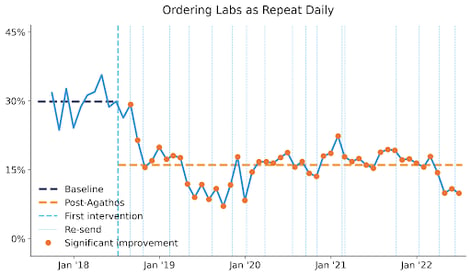DELIVERING TRUSTWORTHY, ACTIONABLE, PEER COMPARISON DATA TO PRIMARY CARE PHYSICIANS
- Michael van Duren, MD, MBA
- 10/17/2023
We are ready to let the world know we have added our Primary Care insight library to Agathos’ solution suite.
Realizing most of you with interest in this category may not be familiar with Agathos, I will share a few examples of the types of success we have seen in the inpatient and emergency settings, and then I will share a little about the types of things we are hoping to see happen on the primary care side. For organizations with a significant amount of value-based care or risk contracts, this will be particularly relevant, as you know the impact primary care has in reducing the total cost of care.
A quick overview of Agathos
Agathos shows primary care physicians how their practice patterns compare to those of their peers. This piques their curiosity and sparks self-determined change that lowers the cost of care and improves patient outcomes. The primary care insights delivered by Agathos are sourced from the EHR (not from claims or payers), reflect encounters as recent as the prior day, and — in contrast to many patient-outcome-level quality metrics — provide clear direction about specific actions in the control of the primary care physicians might want to change about their practice.
The key components of Agathos
While offering data to physicians is nothing new, our approach is different from typical dashboards and other delivery methods:
- Data is sent once per week, via text at the time of a physician’s choosing, and outside of patient-specific workflows
- Each text and supporting link is limited to just one specific practice area (i.e., process metric) per week, to avoid data overload
- The text link seamlessly takes a user to an insight overview featuring an unblinded peer comparison, allowing physicians to see how their score compares with that of their colleagues
- The insight overview includes recent and comprehensive data; such as recent case examples, drilldowns by diagnosis, and a historical lookback: all for better reflective learning
- Additional context (e.g., “Why this Matters,” “Suggestions for Action,” “Calculations/Attributions” sections) makes the metrics more comprehensible and compelling
- User feedback is seamlessly invited via star ratings and comments
What value can you expect from trustworthy, actionable physician data?
Over time we have come to break down our value into four categories: 1) cultural impacts, 2) reduced costs, 3) improved efficiencies, and, most importantly, 4) improved care quality. All of those benefits stem from our focus on reducing unwarranted clinical variation and decreasing low-value care. While we assemble our current data in primary care, consider the following series of graphs that show some of the improvements our hospital clients have enjoyed over the past years.
Clinical decisions
One of the greatest areas of variation between physicians in the hospital and emergency settings is in clinical decisions where there is clinical discretion as to whether and what is done. So, for instance, selection of diagnostic tests. Sometimes the variation is related to EHR settings, other times physicians come in with variable backgrounds/habits/training, and sometimes it is simply a matter of variable clinical judgment. This is undesirable from both a cost and patient care perspective.
One of our hospitalist insights is called “Ordering labs as repeat daily.” The goal of this project was to reduce unnecessary lab tests that were performed because the order was for daily labs with no endpoint. See what happened when we started sending this insight to physicians:

Here's an example from another hospital partner:

Process efficiencies
Another style of Agathos insights focuses on areas where we can improve efficiencies. That is, process items that must happen by a particular time, such as entering a discharge order, or completing medication reconciliation or discharge summary, and there is variation in the timing or success rate by which physicians complete the practice. These efficiencies are generally good for both the hospital and the patient. See examples of change in discharge order timing from a few of our hospital clients, below:


How will primary care be different?
We see opportunities to reduce unnecessary labs (e.g., vitamin D testing), imaging (e.g., imaging for lower back pain), and opioid utilization — as we have seen in the hospital environment. We also see new categories of opportunities — for instance,
- reducing avoidable ED visits and hospitalizations for ambulatory care sensitive conditions
- highlighting missed opportunities for breast and colorectal screenings
- Considering palliative care/ACP for appropriate populations
After the video embedded above went to press, Agathos has started sending primary care insights to residents, APPs, and physicians at Lee Health. We are confident that our proven engagement and peer comparison — combined with innovative text delivery — will translate from the hospital setting to ambulatory. Indeed, we have already seen care improvements in Lee Health’s primary care setting.
To download an overview of Agathos’ Primary Care Library, including a complete list of primary care insights we track and deliver, follow the link below. Alternatively, if you already have metrics you trust at your organization, download an overview of Agathos Engage, which takes your data and delivers it to physicians in a way that is more engaging, i.e., overcoming the barrier of the "last mile."
Thank you for being with us as we move into this exciting new area with great promise towards achieving the goals of value-based care.

About Author

Michael van Duren, MD, MBA
Michael van Duren, MD is Head of Variation Reduction at Agathos. He has 20+ years of experience delivering results at health plans and integrated delivery systems, most recently as VP of Variation Reduction at Sutter Health. His method of pinpointing care variation and facilitating helpful, actionable feedback has won physicians’ trust and generated millions in savings.

